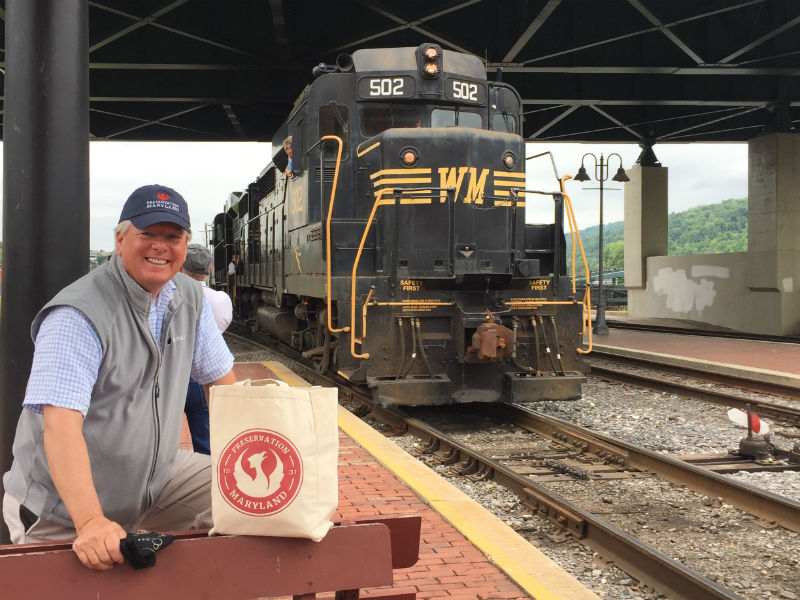Continuing her twenty-four Maryland counties in twenty-four months travelogue, Preservation Maryland Board Vice-President, Diane Caslow, spent a lovely May weekend in Western Maryland. Her travels took her to Cumberland and along to the Western Maryland Scenic Railway to Frostburg and back. Follow along!
THE TRAVELOGUE
Our eighth county on our twenty-four month adventure to explore each of the counties, and Baltimore City, in Maryland was Allegany County. Because Cumberland was a major transportation hub during the 19th century, we decided to explore some of it by rail and foot. Cumberland was known as the Queen City, as it was once the second largest in the state behind Baltimore. It served as a frontier fort, a staging center for western migration through the Allegheny Mountains, a railroad and canal convergence and the origin point of America’s first highway. My husband Jeff, my traveling companion, set off to explore what we could find of the city’s rich history, preservation, continuous use and adaptive reuse. But first, as always, coffee.
After a two hour drive from Baltimore, we start off our walking tour with a beeline to Cafe Mark, a coffee shop on Baltimore Street, the center of the historic downtown Cumberland. The coffee shop is a nice example of adaptive reuse. We head west, crossing over the railroad tracks and first notice a sign in front of a church laying out the outline of the original Fort Cumberland. I can see why it was located there as we are about to climb a very steep hill. Lining the Washington Street Historic District are some well-preserved examples of Greek Revival and Victorian architecture, including the home built for the President of the C&O Canal. We make it to the top, stopping to admire different aspects of all the unique homes, and to catch our breath. When we reach the top of the street, we can see the town below us and the Western Maryland Railroad Station; our next stop.
WESTERN MARYLAND SCENIC RAILWAY
We did not have a sense of how many people would be on the Mountain Thunder, a restored diesel locomotive from the 1960s and thought it might be a quiet ride to Frostburg. The train was packed with bikers, hikers, day trippers and others who just wanted to enjoy the ride. There were at least fifty bikes being loaded onto what looked like a converted coal car for the trip. Many take the train to Frostburg and bike back to Cumberland. Others may be going further as you can bike all or portions of the Great Allegheny Passage connected to the C&O Canal tow path, from Pittsburgh to Washington, D.C.

The Western Maryland Scenic Railroad travels west through a breach in the Allegheny Mountain to Frostburg. It climbs about a 3% grade as Frostburg is nearly 2,100 feet above sea level, while Cumberland is only 627 feet. The train follows the former Western Maryland Railroad right-of-way and then joins the old Cumberland and Pennsylvania Railroad. The scenery was beautiful for a spring day and probably even more spectacular in the Fall. As we were doing a round trip, there is enough time to relax for a picnic or climb the stairs to explore Frostburg’s main street. Back on the train, the motion almost lulls you to sleep, a nice reminder to slow down and just enjoy the ride!
We pick up the C&O Canal Tow Path just south of the Cumberland train station. The C&O Canal operated for nearly 100 years along the Potomac River carrying coal from the Allegheny Mountains. It was designated as a National Historical Park in 1961 to “preserve the neglected remains of the Chesapeake and Ohio Canal and many of its original structures.” Although the canal and towpath trail extends 184.5 miles, we barely walked two miles of it. The real beneficiaries of preservation were the leisurely and hard core bikers flying past us.
DOWNTOWN CUMBERLAND
One more self-guided walking tour leads us through Historic Downtown Cumberland. We saw a number of buildings that have been restored and repurposed. This area has also been designated as an Arts and Entertainment District, with many activities and events to enjoy. This was a quiet Saturday afternoon, so we were just able to admire the many fine examples of commercial buildings all along Baltimore Street. The Rosenbaum Department Store, built in 1899, was the “grandest store of its kind between Pittsburgh and Baltimore.” The Embassy Theater, built in 1913 is a nice example of Art Deco architecture. The original Second National Bank building, constructed in 1890 still shows off its tile covered roof and ornate façade.
I continue to be amazed at the rich and diverse history, architecture, preservation in progress everywhere we go throughout the state! Next Month is Howard County – Mid-Century Comes of Age and Rebuilding After the Flood.
COUNTY-BY-COUNTY INSTALLMENTS
- November 2016: At World’s End in Cecil County
- December 2016: Washington County Bridges
- December 2016: Anne Arundel for a Capital Christmas
- February 2017: Winter Walk in Wicomico County
- March 2017: African-American History in Prince George’s County
- March 2017: Main Street March Madness in Caroline County
- April 2017: Horses and Hounds Byway through Baltimore County
- May 2017: Riding the Rails through Allegany County History

